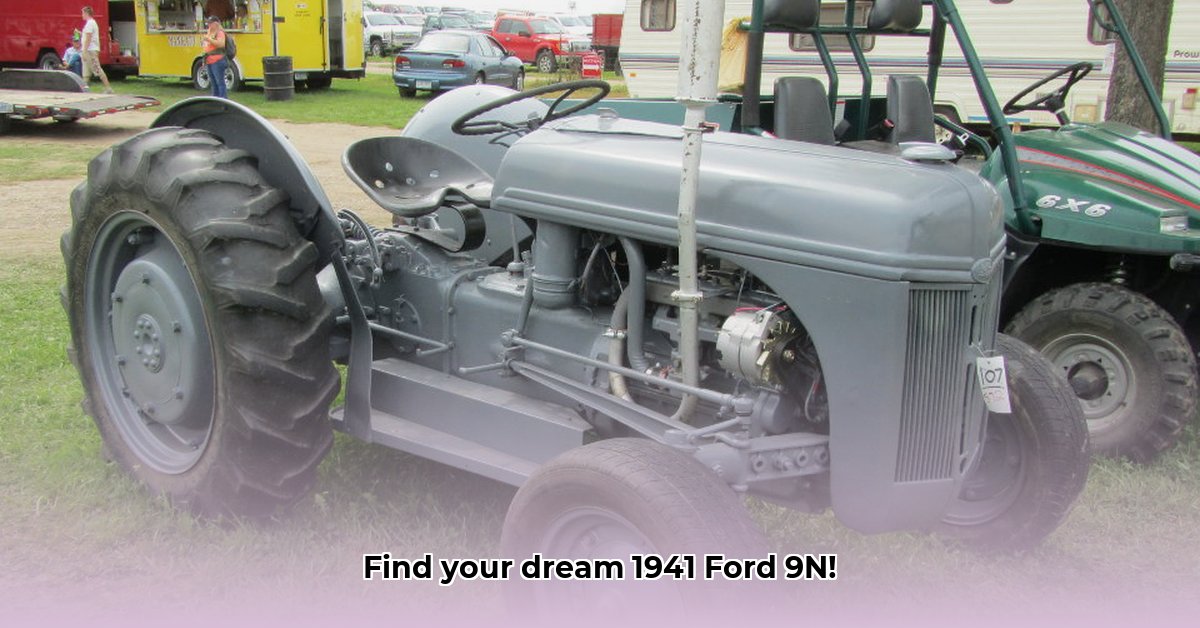
The 1941 Ford 9N tractor: a piece of American agricultural history and a surprisingly robust investment opportunity. This guide serves as both an informational overview and a practical buyer's guide, equipping you with the knowledge to navigate the vintage tractor market with confidence. Whether you're a seasoned collector or a newcomer, we'll cover everything from assessing value to avoiding costly pitfalls. For more pricing information, check out this helpful tractor price guide.
A Blast from the Past: The Ford 9N's Legacy
Introduced in 1939, the Ford 9N wasn't just another tractor; it revolutionized farming. Henry Ford's vision of a simpler, more affordable machine democratized agricultural technology. Innovative features, like its three-point hitch (though less sophisticated than later iterations), set it apart. This straightforward design, combined with surprising durability, explains its enduring popularity among enthusiasts and collectors. The 9N's simple mechanics also make restoration a rewarding project for many.
Market Analysis: Pricing Trends and Factors Influencing Value
Pricing a used 1941 Ford 9N is complex, similar to valuing classic cars. Condition significantly influences value, with a fully restored tractor commanding a significantly higher price than a neglected one. Location also plays a role, as regional demand fluctuates.
Price Range: Expect prices ranging from a few thousand dollars to well over $10,000. This wide range reflects the variability in condition and restoration.
Key Factors Affecting Value:
- Condition: Rust, missing parts, and overall wear heavily influence price. A well-preserved tractor is worth considerably more.
- Restoration: A professional restoration dramatically increases value. The quality of restoration is key here.
- Accessories: Original attachments, such as a front-end loader or other implements, add significant value.
- Location: Regional demand influences pricing; tractors in high-demand areas fetch higher prices.
Decoding Horsepower: Addressing the Confusion
Horsepower figures for the Ford 9N can be misleading. While often cited around 26.5 horsepower, the actual output varies greatly depending on several factors. Different measurement methods (drawbar, PTO, belt) exist, and the engine's condition significantly impacts output. A well-maintained engine will produce more horsepower than a neglected one. Small variations in horsepower figures shouldn't overly influence your decision provided the tractor is mechanically sound. Professional testing is needed for an accurate horsepower assessment.
Buyer's Guide: A Step-by-Step Approach to Purchasing a 1941 Ford 9N
Buying a classic tractor like the Ford 9N requires careful planning and due diligence. This step-by-step guide will help navigate the process:
- Thorough Research: Familiarize yourself with the 1941 Ford 9N's history, common issues, and maintenance requirements.
- Pre-Purchase Inspection: A comprehensive inspection by a qualified mechanic is crucial. Check for rust, leaks, and signs of damage.
- Test Drive (If Possible): If the seller allows, operate the tractor to assess its functionality and responsiveness.
- Verify Documentation: Ensure you have the proper ownership documents, confirming serial numbers and the tractor's history. A clear chain of ownership reduces risk.
- Negotiate Effectively: Negotiate the price based on your inspection, market research, and the tractor's condition. Be prepared to walk away if the price is unreasonable.
Risk Assessment Matrix: Identifying and Mitigating Potential Problems
Buying a classic tractor inherently involves risk. The following matrix helps identify and mitigate potential issues:
| Risk Category | Probability | Impact | Mitigation |
|---|---|---|---|
| Mechanical Issues | Moderate | High | Thorough pre-purchase inspection; secure written quotes for repairs. |
| Parts Availability | Low | Moderate | Research parts suppliers beforehand; join online forums (e.g., Yesterday'sTractors.com) for advice. |
| Questionable History | Low | Moderate | Verify serial numbers; seek supporting documentation (e.g., maintenance records). |
| Market Price Changes | Moderate | Low | Research current market trends before making an offer. |
| Restoration Costs | High | High | Obtain detailed estimates from multiple sources; plan your restoration in stages. |
Restoration & Maintenance: Keeping Your 9N Running Smoothly
Restoring a 1941 Ford 9N can be a rewarding project. However, it requires time, skills, and resources. Connecting with online communities and locating reliable parts suppliers are vital. Preventative maintenance is key to long-term reliability and avoiding costly repairs. Regular oil changes, inspections, and addressing issues promptly are essential.
Conclusion: Owning a Piece of History
The 1941 Ford 9N offers more than just functionality; it represents an era of robust engineering and craftsmanship. Its enduring popularity speaks to its historical significance and the satisfying experience of owning a piece of working history. By following this guide, you’ll be well-equipped to find and purchase a Ford 9N that fits your needs and budget. Remember, thorough research and a cautious approach are key to making a successful investment.